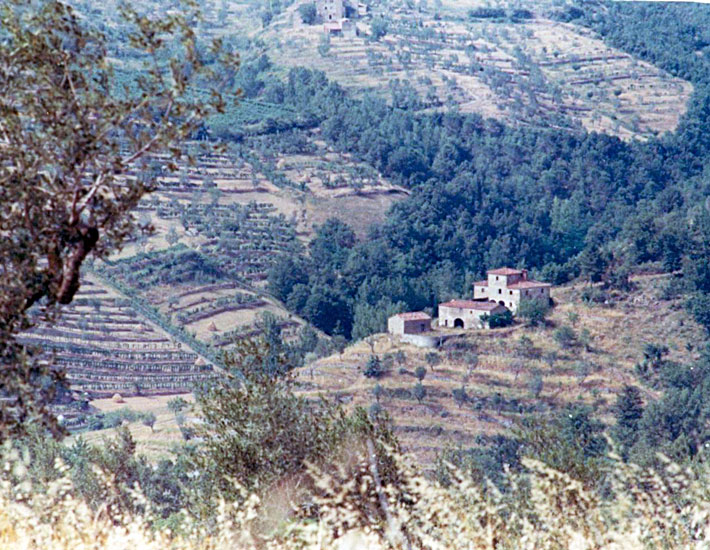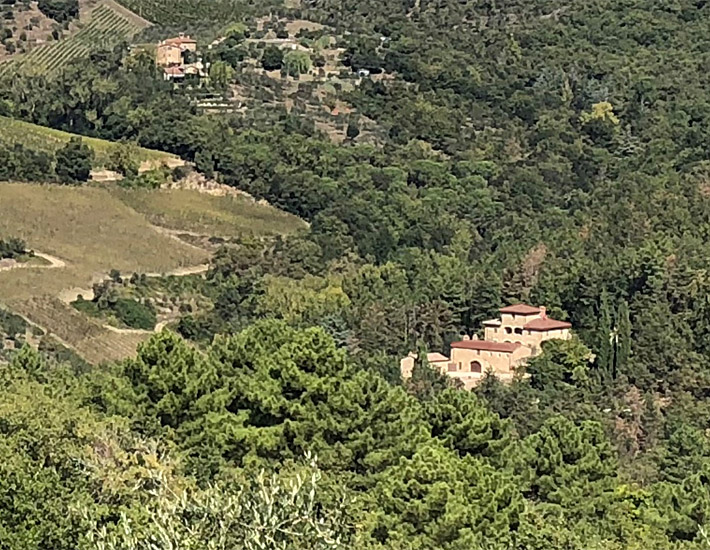A Tuscan Farmhouse
L’Aiaccia was built in 1788 as a working farmhouse in the classic Leopoldina-style. Each of the home’s three levels was originally built for separate purposes. The two adjacent buildings also each had their own function.
- The Ground floor was a stable for animals. The floor was simply dirt and each of the four rooms had its own door to the central open-air entry loggia.
- The First floor was the family living quarters. The large vaulted-ceiling common space served as the living room and kitchen with a huge fireplace for cooking. An open-air loggia plus several other rooms for sleeping and storage were adjacent.
- “Il Torre,” or the Tower, at the top, was used as a pigeon loft, complete with built-in nesting nooks for the pigeons. This space was reachable only by a ladder.
- “La Porcilaia,” the lovely Italian word for pigsty, was across a small courtyard and housed pigs and other smaller farm animals in separate stalls. There was also a large traditional wood-burning oven at one end for baking.
- “Il Fienile,” the small stone barn near the entry gate, was used to store grain and other farm supplies. Adjacent to this barn was an open-air paved threshing floor, the “aia,” for which the house is named.


From Desertion to Rebirth
Like many farmhouses in Tuscany, L’Aiaccia was abandoned in the 1950’s as farmers moved into the cities for work and remained so until 1970 when an adventurous English couple stumbled upon it and bought it. L’Aiaccia at that time still had no running water, no electricity, and no heat. (Pictures below show the villa at that time before the start of its restoration.) This family transformed the ground floor of the main house as well as the Porcilaia into living space. Indoor plumbing, electricity and heat were added. Stairs replaced the ladder to provide access to the Torre which became another bedroom.
In 1999, the property was sold to another English couple who with Bolko Von Schweinichen – a Florence-based architect specializing in historic properties – undertook significant additional restoration of the house. The challenge of any renovation in Tuscany is that the countryside is strictly protected: there can be no external changes to any structure and no new buildings can be built other than restorations using the original footprint. So all work must be undertaken with great care and lots of red tape. The ground floor and first floor were connected internally, a modern kitchen and additional bathrooms were added, and radiant heat was put beneath the terracotta brick floors of the ground floor. Outside, lovely gardens and the spectacular pool were constructed. The renovation was careful to preserve the house’s original character, features and charm while adding full modern comforts.
Becoming L’Aiaccia’s Current Stewards
We first fell in love with L’Aiaccia when we rented the house in 2006, spending two wonderful weeks there with our three young sons and other family. Five years later, by the most random of chances, we learned L’Aiaccia was for sale and we decided fate was telling us to buy it.
As the latest custodians of this special property, we undertook further renovations and extensive maintenance work on the buildings and grounds, bringing back Bolko to oversee the project. We found a way to add air-conditioning to each of the bedrooms with the workmen navigating foot-thick stone walls and leaving virtually no visible sign externally of the modern convenience within. We renovated three of the bathrooms and transformed the small barn into a games room, adding a bathroom. We expanded the gardens, added lighting throughout the grounds, and renovated the upper garden terrace. More recently, we renovated the kitchen and, in 2024, undertook an extensive renovation and updating of the pool and its surrounding seating terraces and garden.
Furnishing the Villa
Having bought the house completely empty, the next challenge was to furnish it. We spent almost two years completing the interiors with the assistance of internationally award-winning interior designer Katharine Pooley. To preserve the house’s historical character, wherever possible we sourced furnishings locally. The house is filled with antique armoires, chests, dressers, tables and mirrors discovered in the antique markets of Florence and Arezzo as well as in local antiquari (antique stores). In addition, we commissioned certain pieces from exceptional local artisans and cabinetmakers. The skillful hands of the master wrought ironmongers of the Biagiotti family made the beautiful custom-designed wrought iron beds and tables as well as many of the light fixtures, lamps, the extraordinary dragon chandelier in the barn and L’Aiaccia’s fabulous dragon flag holders. We commissioned the library bookcase from a century-old family workshop north of Florence. Custom sofas and armchairs throughout were made in London and designed for maximum comfort. We sourced Italian travel posters, art and local ceramics to grace the walls. We filled the kitchen with everything someone who likes to cook would want and had Italian coverlets made for the beds.
We were constantly amazed by the artistry of the local Italian artisans; the excellence of the contractors we worked with; the resourcefulness and terrific oversight of our villa manager, Elisa; the skill and can-do attitude of our late jack-of-all-trades gardener, Sandro; the generous care of our housekeeper, Nicoletta; and the craziness of some of the Italian bureaucracy we had to navigate along the way. It was quite an adventure!
Today
Italy has long valued the remarkable beauty and important history of the Chianti region as have visitors who have traveled here for centuries. The government’s historic preservation efforts have kept the towns and countryside looking much the same as centuries past and have been key to the region’s continued status as one of the top tourist destinations in the world. At L’Aiaccia, you can step back in time, but with great appreciation for all the modern comforts at hand. Immersed in the glorious Chianti countryside, it is hard not to reflect on the hundreds of years of the often surprisingly turbulent history of this place, which is now so peaceful. L’Aiaccia will continue its story as a very special, extremely comfortable retreat which we are happy to share with our guests.







